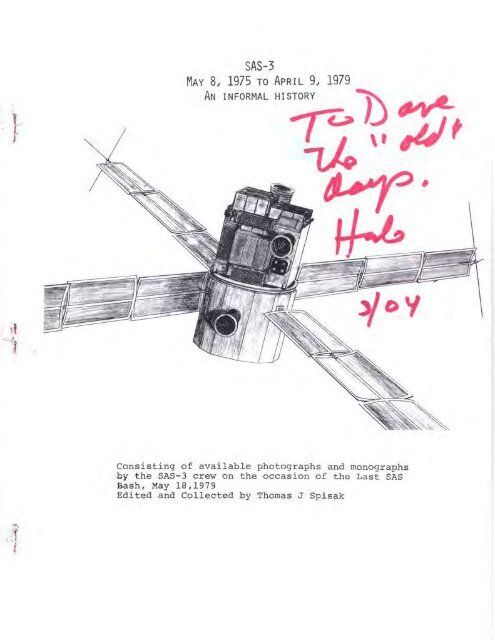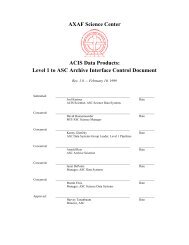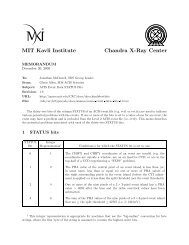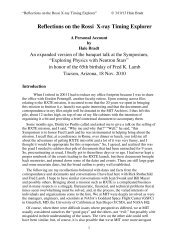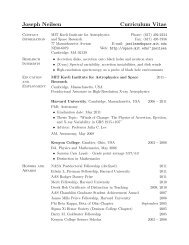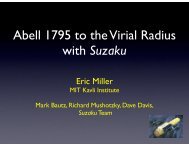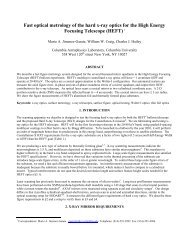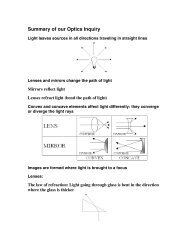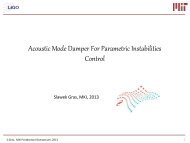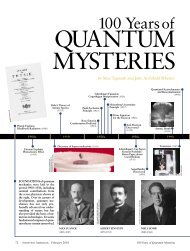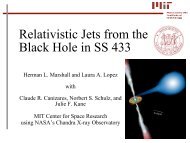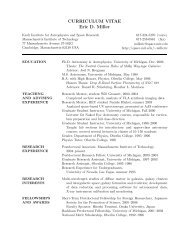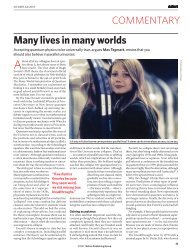SAS-3 mission - MIT Kavli Institute for Astrophysics and Space ...
SAS-3 mission - MIT Kavli Institute for Astrophysics and Space ...
SAS-3 mission - MIT Kavli Institute for Astrophysics and Space ...
You also want an ePaper? Increase the reach of your titles
YUMPU automatically turns print PDFs into web optimized ePapers that Google loves.
Preface (April 2009)<br />
Background on <strong>SAS</strong>-3<br />
(in orbit 1975-79)<br />
The Small Astronomy Satellite #3 (<strong>SAS</strong>-3) – we never gave it a jazzy name – was a<br />
NASA/<strong>MIT</strong> satellite that carried out observations of celestial x-ray sources in the second<br />
decade of celestial x-ray astronomy. X-ray astronomy began with the discovery of the<br />
first celestial x-ray source with a sounding rocket flight in 1962 (Giacconi, R., Gursky,<br />
H., Paolini, F., Rossi, B. 1962, Phys. Rev. Lett. 9, 439 (1962)). (X-rays do not transit<br />
the atmosphere so one’s instruments must be carried above most of the atmosphere.)<br />
Rockets provided only five minutes of observation time, but satellites could provide<br />
nearly continuous observations <strong>for</strong> several years. We now know that the brighter<br />
celestial x-ray sources are primarily neutron-star or black-hole binary stellar systems,<br />
supernova remnants, the active nuclei of galaxies, <strong>and</strong> the gases in clusters of galaxies.<br />
X-ray astronomy is now a full-fledged branch of astronomy.<br />
This booklet was put together in May 1979. It describes experiences from the very early<br />
days of satellite astronomy. It consists of photos of the scientific <strong>and</strong> engineering<br />
participants in the <strong>SAS</strong>-3 project at <strong>MIT</strong> <strong>and</strong> the reminiscences of many of them just<br />
after the completion of the <strong>mission</strong>. I believe it was my idea to spice up our post reentry<br />
party ("Last <strong>SAS</strong> Bash") with such a booklet, which we could <strong>and</strong> did present to<br />
the Principal Investigator, Prof. George W. Clark, with copies to all. I asked our data<br />
aide Tom Spisak to pull it together <strong>and</strong> to be the one to pester people to write up their<br />
contributions. Tom also took most of the pictures. More typical of those days, some<br />
were not com<strong>for</strong>table telling their personal stories <strong>for</strong> public consumption but many<br />
overcame this <strong>and</strong> did contribute. I believe we are richer <strong>for</strong> it.<br />
The scientific payload of <strong>SAS</strong>-3 was entirely conceived <strong>and</strong> constructed by our group at<br />
<strong>MIT</strong> (The Rossi group). George’s “co-investigators” were physics faculty members<br />
Herbert Schnopper, Walter Lewin, <strong>and</strong> myself. We each had our "own" instrument on<br />
board, but all instruments were available to whomever was the active observer. Each of<br />
us had our own science programs <strong>and</strong> operated relatively independently. Other faculty,<br />
staff members <strong>and</strong> students became deeply involved. Other major players in the<br />
science included (Drs <strong>and</strong> Profs) Claude Canizares, John Delvaille, Rodger Doxsey,<br />
David Hearn, Jeffrey Hoffman, Garrett Jernigan, Paul Joss, Fred Marshall, Terry<br />
Matilsky, Jeff McClintock, Larry Petro, Saul Rappaport, <strong>and</strong> George Ricker. During<br />
fabrication of the payload, Project Scientist Bill Mayer was our principal liaison with the<br />
engineers, thus ensuring that the four principals were pulling in the same direction,<br />
while Bob Rasche <strong>and</strong> later Dick Taylor supervised the engineering as Project<br />
Engineer. Our technical crew included Ed Boughan, Mike Doucette, <strong>and</strong> many others<br />
(see photos in the booklet). After launch, Bill remained the keystone of spacecraft<br />
operations <strong>and</strong> safety at <strong>MIT</strong>. Marjorie Townsend of GSFC/NASA was our Project<br />
Manager. (See the photos <strong>for</strong> more participants.)
<strong>SAS</strong>-3 was launched successfully into an equatorial orbit at about 500 km altitude on<br />
May 8, 1975 from the Italian San Marco launch plat<strong>for</strong>m just off the coast of Kenya,<br />
Africa; it reentered the atmosphere on April 9, 1979. It followed the pioneering <strong>SAS</strong>-1<br />
(Uhuru), which was in orbit from 1970 to 1973. Uhuru established the binary nature of<br />
one class of x-ray sources <strong>and</strong> the diffuse e<strong>mission</strong> from clusters of galaxies among<br />
other significant discoveries. The British Ariel-5 was launched some months prior to<br />
<strong>SAS</strong>-3 with similar <strong>and</strong> also complementary capabilities. It too was a highly productive<br />
<strong>mission</strong>. Uhuru was a high bar to reach <strong>and</strong> competition from Ariel-5 encouraged<br />
greatly our science ef<strong>for</strong>ts, <strong>and</strong> vice versa from what they tell me.<br />
While on orbit, comm<strong>and</strong>s to <strong>SAS</strong>-3 were sent directly from the Goddard <strong>Space</strong> Flight<br />
Center (GSFC) control center, but we used a primitive facsimile machine (fax) to send<br />
comm<strong>and</strong>s, orbit by orbit, from <strong>MIT</strong> to GSFC, <strong>for</strong> <strong>for</strong>warding on to the satellite. <strong>SAS</strong>-3<br />
could point to a celestial position but would drift a few tenths of a degree per orbit, so<br />
constant tweaking of the magnetic torquing-coil currents was required to keep our ~1<br />
deg collimators pointed toward an x-ray source. For this, <strong>and</strong> to respond to other<br />
eventualities, we continuously (24-7) manned the <strong>MIT</strong> control center with a single duty<br />
scientist or technician. I believe I was the first to introduce the term “duty scientist” into<br />
the x-ray astronomy lexicon. (The genesis of this term was “duty officer” from my twoyear<br />
duty on a Navy cargo ship, though I did not advertise this because military<br />
references were not generally viewed favorably in those days.)<br />
The science was initially in the h<strong>and</strong>s of our group alone. George Clark would decide on<br />
priorities, based on brief proposals. Nevertheless each subgroup could be assured of<br />
significant observing time each week or month <strong>and</strong> anybody's bright idea was likely to<br />
lead to an observation the following week or month – or even that very day!. The<br />
science <strong>and</strong> the objectives moved fast. Scientists from other institutions did visit <strong>and</strong><br />
participate. (I remember Laura Maraschi from Italy <strong>for</strong> example), <strong>and</strong> later in the<br />
<strong>mission</strong>, guest observers were accepted by NASA. All in all, those four years were one<br />
wild ride <strong>for</strong> the participants, <strong>and</strong> I am pleased that this little booklet is still around to<br />
remind us of those days.<br />
The science results from <strong>SAS</strong>-3 were indeed impressive, even from the perspective of<br />
2009. The instruments <strong>and</strong> science results are briefly summarized in the following<br />
published selection from the Annual Reviews of Astronomy <strong>and</strong> <strong>Astrophysics</strong>; the<br />
journal references are easily located with the <strong>Astrophysics</strong> Data System (ADS):<br />
http://adsabs.harvard.edu/abstract_service.html.<br />
“3.4.2 The <strong>SAS</strong>-3 <strong>mission</strong> was designed as a spinning satellite, but its spin rate was<br />
controlled by a gyroscope that could be comm<strong>and</strong>ed to stop the spin. Thus all its<br />
instruments could be pointed to a position on the sky, albeit with a modest drift. This<br />
provided ~30-min. continuous trains of data from pulsars, bursters <strong>and</strong> transient<br />
sources, a novel capability <strong>for</strong> X-ray astronomy. <strong>SAS</strong>-3 carried a proportional counter<br />
array with slat <strong>and</strong> tubular collimators (~0.03 m 2 ) (Buff et al 1977, Lewin et al 1976a), a
small collector system with thin window proportional counters <strong>for</strong> the study of ~0.2 keV<br />
e<strong>mission</strong> (Hearn et al 1976a), <strong>and</strong> a modulation collimator system of substantial area<br />
(0.03 m 2 ) to measure source positions to ~1' (Schnopper et al 1976, Doxsey et al 1976).<br />
The scientific yield included (i) the discovery of a dozen X-ray burst sources (Lewin &<br />
Joss 1981) including the dramatic <strong>and</strong> unique 'rapid burster' (Lewin et al 1976b) which<br />
probably gains its energy from accretion instabilities rather than nuclear flashes, (ii) the<br />
discovery of the first highly magnetic white-dwarf binary system (AM Her) through its Xray<br />
e<strong>mission</strong> (Hearn et al 1976b), <strong>and</strong> the discovery of X-ray e<strong>mission</strong> from HZ 43<br />
(Hearn et al 1976a; see also Rockets above), (iii) an all-sky survey of the soft X-ray flux<br />
(Marshall & Clark 1984), <strong>and</strong> (iv) the precise celestial locations of ~60 X-ray sources<br />
which identified Algol as an X-ray emitter (Schnopper et al 1976), established Be-star<br />
binaries as a class of X-ray emitters (Bradt et al 1977), brought about the first<br />
identifications of bursting X-ray sources with visible stellar systems (McClintock et al<br />
1977), identified the first quasar located through its X-ray e<strong>mission</strong> (Ricker et al 1978),<br />
<strong>and</strong> demonstrated the central location of X-ray sources in globular clusters (Jernigan &<br />
Clark 1979).” [From H. Bradt, T. Ohashi & K Pounds, , Ann. Rev. Astron. Astrophys. 30,<br />
402–3 (1992)]<br />
My thanks to Dave Pooley <strong>for</strong> the good sense to put this on the internet <strong>for</strong> all to see.<br />
Hale Bradt<br />
(April 2009)


